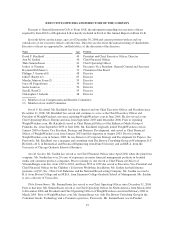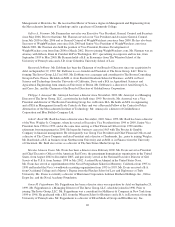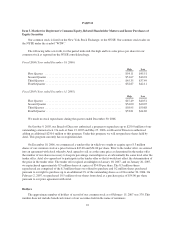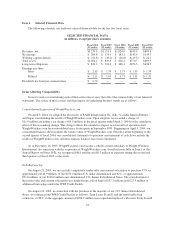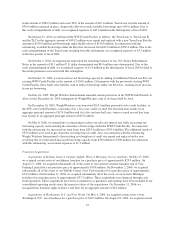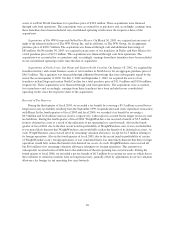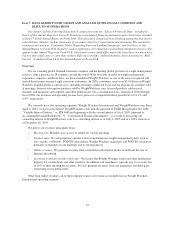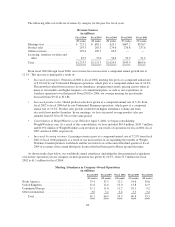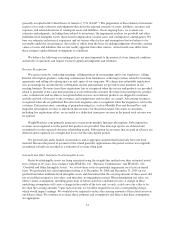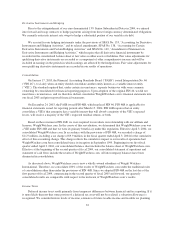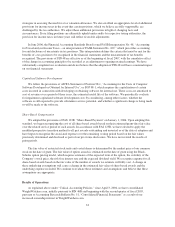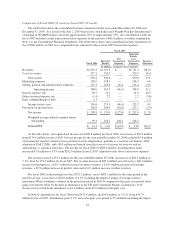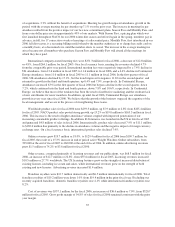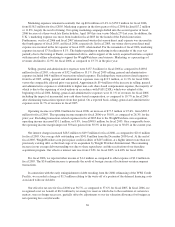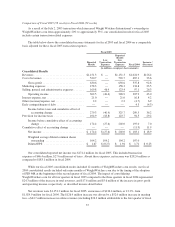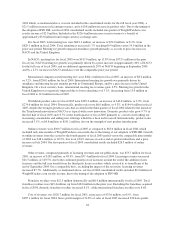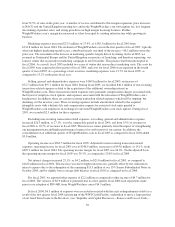WeightWatchers 2006 Annual Report Download - page 42
Download and view the complete annual report
Please find page 42 of the 2006 WeightWatchers annual report below. You can navigate through the pages in the report by either clicking on the pages listed below, or by using the keyword search tool below to find specific information within the annual report.Beginning in late 2003, our NACO attendance growth was adversely affected by increased media exposure
to and the resulting popularity of low-carbohydrate diets, which continued through 2004. Beginning in the third
quarter of fiscal 2004 through the first quarter of fiscal 2005, the declines in organic NACO attendance
(excluding the impact of acquisitions) versus prior year periods steadily improved from minus 16.7% in the
second quarter of fiscal 2004 to minus 13.9% in the third quarter of fiscal 2004 to minus 8.7% in the fourth
quarter of fiscal 2004 and to minus 5.1% in the first quarter of fiscal 2005. After that, NACO attendance versus
prior year periods moved into positive territory and has posted increases since, up 5.3%, 2.5% and 6.5% in the
second, third and fourth quarters of fiscal 2005, respectively. The third quarter of fiscal 2005 grew at a slower
pace due to the impact of Hurricane Katrina and its aftermath, compounded by two subsequent hurricanes. In
fiscal 2006, attendance for the full year grew at a rate of 5.7%, 2.9% without the benefit of acquisitions.
In the United Kingdom, after four years of attendance increases, attendance declined 3.1% in fiscal 2005
and 7.4% in 2006. The declining trend began as a result of a negative member and leader reaction to a new
program innovation launched in January 2005. During the past 18 months, we have worked to simplify the
program, improve the meeting experience, and strengthen the quality of our field management and leader force.
As a result, over the course of fiscal 2006, the negative UK attendance trend has reversed from a negative 17.2%
year-over-year decline in the first quarter, to an 11.6% decline in the second quarter, to increases of 0.4% and
7.0% in third and fourth quarters of fiscal 2006, respectively.
In Continental Europe, attendance increased 1.1 million in fiscal 2004 primarily as a result of the program
innovation in the third quarter. We maintained this increased attendance in Continental Europe in fiscal 2005,
however in fiscal 2006, attendances in Continental Europe declined by 4.4%. After a 6.3% increase in the first
quarter of fiscal 2006, Continental Europe’s attendances started to decline, 7.2% in the second quarter, 7.8% in
the third quarter and 10.6% in the fourth quarter. We believe that most of this weakness has been the result of
ineffective marketing and the resultant lack of new enrollments for never members. In addition, up until fiscal
2006, Continental Europe saw attendance growth in every year since fiscal 2000. We believe that the growth of
the business outpaced the expertise of the local management, and we are in the process of strengthening these
teams.
We have maintained an annual gross margin in the Weight Watchers International operating segment of
50% or more since fiscal 2001. Our staff is usually paid on a commission basis and space is typically rented as
needed. Moreover, we adjust the number of meetings according to demand, including seasonal fluctuations. This
variable cost structure has enabled us to maintain these high margins even as we have expanded the number of
our meetings over this period. When our attendance growth outpaces our meeting growth, our gross margins
typically improve.
The Weight Watchers International operating segment has consistently generated operating income margins
of 30% or more from fiscal 2001 to fiscal 2005, even while making significant investments in strengthening our
management teams, particularly in North America and Continental Europe, and putting in place a stronger global
marketing infrastructure. In fiscal 2006, the operating income margin dipped slightly below, to 29.2%, as a result
of costs associated with the ramp up of our new Monthly Pass commitment plan in NACO.
Performance Indicators and Market Trends
Our management reviews and analyzes several key performance indicators in order to manage our business
and assess the quality and potential variability of our cash flows and earnings. These key performance indicators
include:
• net revenues, which are an indicator of our overall business growth;
• attendance;
• meeting fee revenue per attendee and in-meeting product sales per attendee;
29


